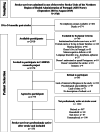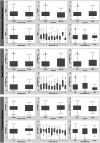Professional reintegration of stroke survivors and their mental health, quality of life and community integration
- PMID: 39384725
- PMCID: PMC11599299
- DOI: 10.1007/s11136-024-03797-8
Professional reintegration of stroke survivors and their mental health, quality of life and community integration
Abstract
Purpose: To assess the association between professional reintegration and mental health, quality of life (QoL) and community reintegration of stroke survivors.
Methods: Using a cross-sectional study design, a structured questionnaire was administered to previously working stroke survivors, 18-24 months post-stroke. Data on sociodemographic characteristics, professional reintegration (prevalence of return to work (RTW), period of RTW, job placement, function at work, reintegration support, association of stroke with work and number of working hours), mental health (Hospital Anxiety and Depression Questionnaire), QoL (Stroke Specific Quality of Life Scale) and community integration (Community Integration Questionnaire) were reported by 553 stroke survivors.
Results: Twenty months after stroke, 313 (56.6%; 95%CI 52.4-60.8) stroke survivors had return to work. RTW was positively associated with both global and sub-domains scores of Community Integration Questionnaire (CIQ) (global CIQ β = 3.50; 95%CI 3.30-3.79) and with depressive symptomatology (β = 0.63; 95%CI 0.20-1.46) measured by the Hospital Anxiety and Depression Scale. No significant differences were found regarding QoL, according to RTW status. For those who RTW, no significant associations were found between any of the professional reintegration determinants assessed and mental health, QoL and community integration scores.
Conclusions: RTW seems to be associated to better community integration after stroke, but appears to be negatively associated to stroke survivor's mental health, namely considering depression symptoms. Future studies should explore the barriers to stroke survivors' RTW and the challenges and strategies used to overcome them, to allow the development of professional reintegration policies.
Keywords: Mental health; Professional reintegration; Quality of life; Rehabilitation; Return to work; Stroke.
Plain language summary
Stroke represents a leading cause of death and a major cause of disability. In professionally active ages, stroke has a major impact on stroke survivors’ professional reintegration and on return to work, and special attention should be paid on how much this is associated with their quality of life, anxiety and depression symptoms, and community integration. This knowledge contributes to the development of patient centered interventions, across their rehabilitation pathway. The present study indicate that most stroke survivors return to work within the first six months after event, without any social or vocational support, and that return to work seems to be associated to better community integration. There was no difference on quality of life between stoke survivors who return to work and those who did not. Survivors who return to work appear to have more depressive symptoms than those who do not. Authors believe that lack of vocational support after stroke contributes to a maladaptive return to work that do not consider stroke survivors’ needs appropriately. These results highlight the importance of investing in professional reintegration with structured vocational programs to improve stroke survivors’ quality of life and mental health.
© 2024. The Author(s).
Conflict of interest statement
Declarations. Competing interests: The authors have no relevant financial or non-financial interests to disclose.
Figures
References
-
- Gorelick, P. B. (2019). The global burden of stroke: Persistent and disabling. Lancet Neurology, 18(5), 417–418. 10.1016/s1474-4422(19)30030-4 - PubMed
-
- Organization, W. H. (2001). International Classification of Functioning, disability and health (ICF). WHO.
-
- Gough, C., Baker, N., Weber, H., et al. (2022). Integrating community participation in the transition of older adults from hospital to home: A scoping review. Disability and Rehabilitation, 44(17), 4896–4908. 10.1080/09638288.2021.1912197 - PubMed
MeSH terms
LinkOut - more resources
Full Text Sources
Medical



